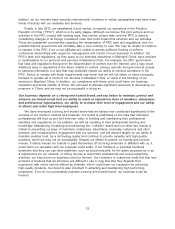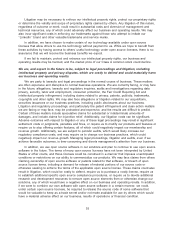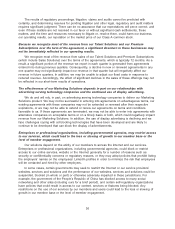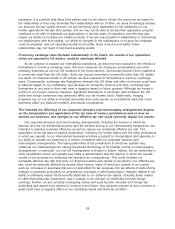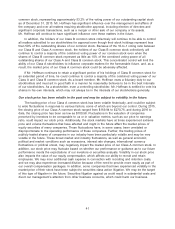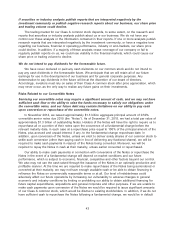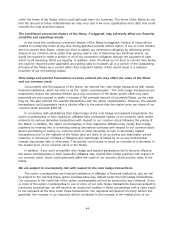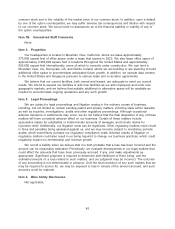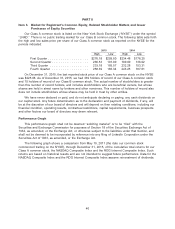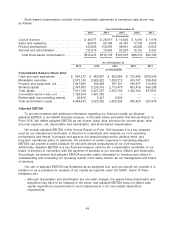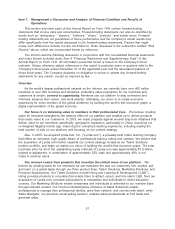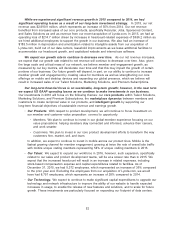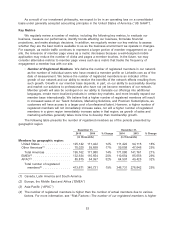LinkedIn 2015 Annual Report Download - page 45
Download and view the complete annual report
Please find page 45 of the 2015 LinkedIn annual report below. You can navigate through the pages in the report by either clicking on the pages listed below, or by using the keyword search tool below to find specific information within the annual report.If securities or industry analysts publish reports that are interpreted negatively by the
investment community or publish negative research reports about our business, our share price
and trading volume could decline.
The trading market for our Class A common stock depends, to some extent, on the research and
reports that securities or industry analysts publish about us or our business. We do not have any
control over these analysts or the information contained in their reports. If one or more analysts publish
research reports that are interpreted negatively by the investment community, or have a negative tone
regarding our business, financial or operating performance, industry or end-markets, our share price
could decline. In addition, if a majority of these analysts cease coverage of our company or fail to
regularly publish reports on us, we could lose visibility in the financial markets, which could cause our
share price or trading volume to decline.
We do not intend to pay dividends for the foreseeable future.
We have never declared or paid any cash dividends on our common stock and do not intend to
pay any cash dividends in the foreseeable future. We anticipate that we will retain all of our future
earnings for use in the development of our business and for general corporate purposes. Any
determination to pay dividends in the future will be at the discretion of our board of directors.
Accordingly, investors must rely on sales of their Class A common stock after price appreciation, which
may never occur, as the only way to realize any future gains on their investments.
Risks Related to our Convertible Notes
Servicing our convertible notes may require a significant amount of cash, and we may not have
sufficient cash flow or the ability to raise the funds necessary to satisfy our obligations under
the convertible notes, and our future debt may contain limitations on our ability to pay cash
upon conversion or repurchase of the convertible notes.
In November 2014, we issued approximately $1.3 billion aggregate principal amount of 0.50%
convertible senior notes due 2019 (the ‘‘Notes’’). As of December 31, 2015, we had a total par value of
approximately $1.3 billion of outstanding Notes. Holders of the Notes will have the right to require us to
repurchase all or a portion of their notes upon the occurrence of a fundamental change before the
relevant maturity date, in each case at a repurchase price equal to 100% of the principal amount of the
Notes, plus accrued and unpaid interest, if any, to the fundamental change repurchase date. In
addition, upon conversion of the Notes, unless we elect to deliver solely shares of our common stock to
settle such conversion (other than paying cash in lieu of delivering any fractional shares), we will be
required to make cash payments in respect of the Notes being converted. Moreover, we will be
required to repay the Notes in cash at their maturity, unless earlier converted or repurchased.
Our ability to make cash payments in connection with conversions of the Notes or repurchase the
Notes in the event of a fundamental change will depend on market conditions and our future
performance, which is subject to economic, financial, competitive and other factors beyond our control.
We also may not use the cash raised through the issuance of the Notes in an optimally productive and
profitable manner. At the time we are required to make repurchases of the Notes being surrendered or
converted at their maturity, we may not have enough available cash or be able to obtain financing to
refinance the Notes on commercially reasonable terms or at all. Our level of indebtedness could
adversely affect our future operations by increasing our vulnerability to adverse changes in general
economic and industry conditions by limiting or prohibiting our ability to obtain additional financing for
future capital expenditures, acquisitions and general corporate and other purposes. If we are unable to
make cash payments upon conversion of the Notes we would be required to issue significant amounts
of our Class A common stock, which would be dilutive to existing stockholders. In addition, if we do not
have sufficient cash to repurchase the Notes following a fundamental change, we would be in default
43


